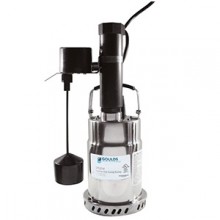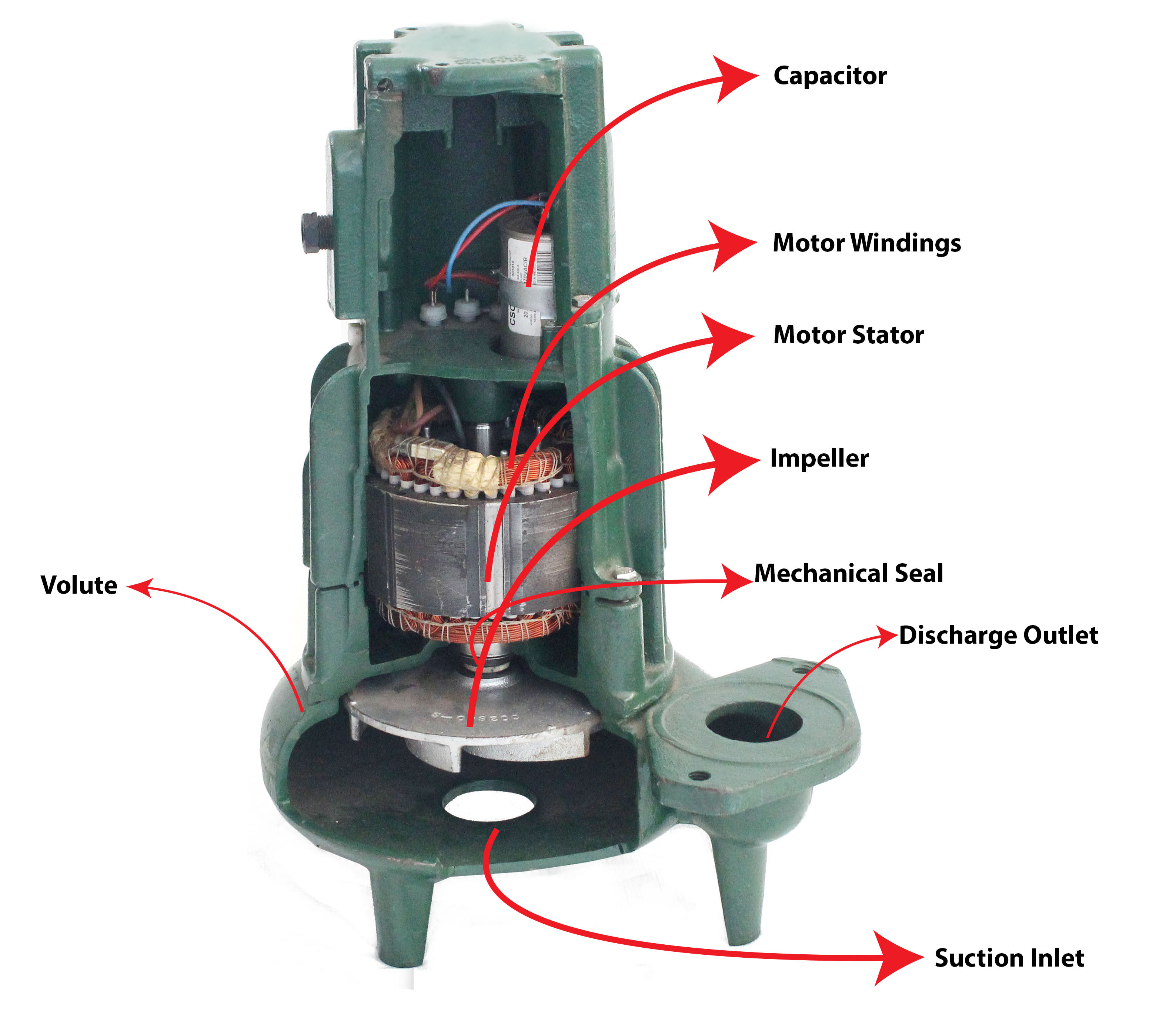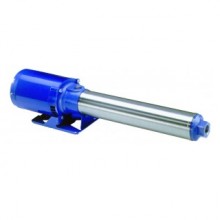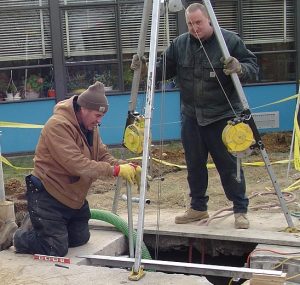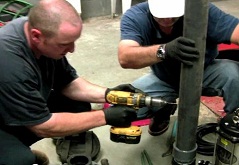-
How to Install a Sump Pump and Sump Pit System
July 29, 2016Anyone who has a basement sump pump understands the importance of proper sump functionality to keeping a basement unit free from flooding.The sump pump is simply a pump that moves accumulated groundwater out of the home. They are usually installed in basements or crawl spaces and reside in sump pits. Sump pumps are necessary for homes that sit above a high water table or have frequent basement flooding issues. When groundwater starts to accumulate underneath the home, it will inevitably rise and put pressure on the concrete floor. Digging a sump pit in the earth gives the groundwater another path to travel, the path of least resistance. As the water moves into the sump pit, the sump pump ejects that water out of the home. You may know that your home basement has a slight flooding problem but what if you do not know how to install a sump pump or sump pit This blog will walk you through the process step-by-step. (more…)
-
Why Your Sump Pump Needs a Vent Hole
July 29, 2016This video details why you should drill a horizontal vent hole (or weeping hole) into the discharge pipe of your sump pump. The vent hole allows excess air to escape from the pipe, preventing air bounding.
-
Get to Know Your Pump: Parts Breakdown
July 28, 2016Pump Products expert Matt breaks down the parts of a pump and how these parts work together to move fluid for any application. Parts examined include the impeller, motor and mechanical seal. Not every pump will look exactly the same, but after watching this video you should have a basic idea of how these marvels of engineering work.
-
How Fountain Pumps Power Artistic Water Displays
July 27, 2016From the public wishing fountains found in many city squares to the grand water shows in places like Las Vegas and Dubai, water fountain displays are aesthetic marvels that tend to draw large, admiring crowds. In the days of the ancient Romans, gravity-fed fountains served as an important source of bathing, washing and drinking water for the public. Today, sophisticated fountain pumps power water fountain displays. The Trevi Fountain in Rome is a prime example of how modern pumping technology has interacted with classical design to preserve an artifact of Post-Renaissance Rome. An icon of Baroque era architecture and a symbol of Roman mythology, the Trevi fountain is arguably the most famous fountain display in the world. Artisans refurbished the deteriorated surface and engineers installed recirculating pumps in 1998. The pumps ensure that the Trevi will continue to dazzle modern audiences for many years to come. (more…)
-
Pump Products Installs New Sewage Pumps to Relieve Lady Liberty
July 21, 2016One of the country’s proudest landmarks received a critical upgrade thanks to New Jersey-based businesses Pump Express and Public Sewer Service. Pump Express and Public Sewer Service, affiliate businesses of Pump Products, refurbished the entire sewage system for Liberty Island, longtime home of the Statue of Liberty. The renewal project was part of the continued efforts to restore the proud historical site after the extensive damage caused by Hurricane Sandy. When the storm touched down in October 2012, many coastal communities in the Northeast suffered heavy losses and Liberty Island was no exception. Sandy devastated the supporting infrastructure that kept the island functional as a tourist attraction. The Statue itself remained relatively unscathed thanks to a design that allows the structure to sway with the wind. Although Liberty Island reopened as a tourist attraction in 2013, the scars of the damage remain and recovery has been a steady process. According to the National Park Service website, the storm rendered the docks and pathways unusable. “Electric, water, sewer, HVAC systems, phone systems, security systems, and radio equipment,” were completely destroyed. At the peak of the flooding, water covered over 75% of Liberty Island. (more…)
-
How to Identify the Parts of a Sewage Pump
July 19, 2016Most people never consider the components of a pump until one breaks. If you are not getting water or your basement is flooded, you might know that something is wrong with the pump - but you have no idea what you're looking at. In this blog, we will break down the parts of a submersible sewage pump to give you a better understanding of how a pump is constructed how the parts fit together to move fluid. Why should you be able to identify pump repair parts As with any other piece of mechanical equipment, familiarity with the components can help you understand proper functioning, assist you in diagnosing potential problems and enable you to repair the pump yourself, should you be so inclined. Plus, a little extra knowledge never hurt anybody. Pump Components A pump is composed of two main parts: the volute and the motor. A volute is the curved casing that receives the fluid. The fluid’s rate of flow decreases while the flow pressure increases. (more…)
-
How To Calculate GPM for a Potable Water System
July 15, 2016Pump Products explains how to calculate your water flow requirements, measured in Gallons Per Minute (GPM), for a potable water system. This video will give you a step-by-step guide to the various methods of calculating potable GPM. Potable water is the water you use for drinking, cleaning and everyday life. Understanding the water flow requirements for your house or place of business can help you address problems, save money and size or select a pump.
-
When Do You Need a Water Pressure Booster Pump?
July 14, 2016Low water pressure is one of the problems that consistently bedevils residences and businesses alike. Water pressure, not to be confused with water flow at the tap, is simply the force that propels water through the piping system to reach fixtures in the building unit. People desire high water pressure for many different reasons and there are as many different ways to try to achieve it. One way is using a water pressure booster pump. Water pressure results from several variables, including the height of the water reservoir, the elevation of the property or premise, the number of people occupying the premise that consume water as well as their consumption rates and the number of water fixtures (sink, toilet, etc.) within the premise. If you are experiencing low water pressure, perhaps you have tried one of these methods. You might have tried to clean or adjust the aerators in the faucet heads. You have tried retrofitting your pipes to a larger size to increase the volume. You even may have resorted to calling in an inspector from a municipal water service. All to no avail. Each method has its pros and cons, but if you are looking for a relatively straightforward solution, consider buying a water pressure booster pump. Booster pumps are additions to a system used to increase fluid pressure in that system. A pressure tank stores the water and maintains the pressure within a certain range so that the booster pump is not constantly turning on and off every time you flip your sink handle or flush a toilet. A pressure switch with preset maximum/minimum PSI settings is used to regulate the pump’s activity level. Booster pumps can be found in both residential and commercial properties, in large homes and small homes, in corner stores and big factories, in farms and in car washes. Some use boosters simply for comfort, while others rely on them to run a business or even for drinking water. Some of the top manufacturers of booster pumps are Goulds, Sta-Rite, Berkeley and Grundfos. Discussed below are some of the most common applications in which booster pumps play a vital role. (more…)
-
How To Size a Sewage Pump System
July 12, 2016Sewage stinks. It’s not a very pleasant thing to think about and most people probably would prefer their sewage to be out of sight and out of mind. Few things are as big a headache for a property owner or municipality manager as backed up sewage water. Whether the building in question is a home or business, the smell of sewage can produce a dreadful environment. Removing wastewater and sizing a new pump for your sewage pump system is an involved process. If you are experiencing a problem such as the sewage water backing up or simply not draining quickly enough, it is important to determine the origin of the problem and think about possible solutions. If a pump stopped working because of age or natural wear, it is easy enough to replace the old model with a new one. But you should take the opportunity to examine the holistic health of your sewage system. Similarly, if you are building a new house or you just refurbished your basement and want to add a bathroom, it is imperative to consider all the aspects of wastewater removal in your system. If the system is a new project, you may need to dig a new sewage pit to have a basin installed. Examining the whole of a system can help you update your infrastructure to comply with new codes, identify potential problem points before they occur or simply make your fluid transportation more efficient, saving time and money in the long run. This blog post will walk you through the process of sizing a sewage pump for a system. First, it is essential to understand the basics of municipal sewage systems and whether or not you actually need a sewage pump. (more…)
-
How to Calculate GPM For a Wastewater System
July 7, 2016Tutorial video on how to calculate the required water flow in GPM (gallons per minute) to remove wastewater from your house or building.
-
Pump Installation: Troubleshooting Common Issues
July 5, 2016Imagine you just bought a new sump pump. You feel at ease because you no longer have to worry about the water in your basement sump pit flooding your house. You did all the preliminary research , you talked to experts and you’re confident that you picked a dependable product. All that's left is the actual pump installation and troubleshooting the most common issues. Of course, even if you picked the right pump for you, with installation comes a unique set of complications and obstacles. When customers have problems with their pumps - loud noises, wear and tear, inefficient water flow - many times the problem has its roots in how the pump was installed. Pump Products experts have identified several common problems that typically result from improper installation and how to troubleshoot these problems. We strongly recommend that you have a licensed professional handle all installations of pumps, motors and attendant electrical equipment. This guide is intended for educational purposes. Pump Installation Issues Troubleshooting electrical problems --Incorrect wiring can sometimes cause the motor to rotate in reverse - the fluid may still move but it could damage the pump in the long term. Bad wiring can also short out the pump. Most manufacturers provide an installation schematic or manual to help guide a contractor through the installation process. The schematic should break down the components of your equipment’s wiring. Here’s a typical example from Goulds Pumps. (more…)


